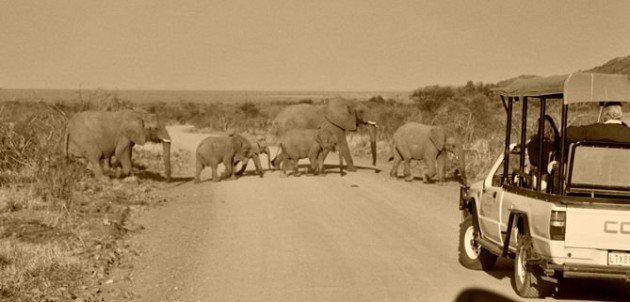
A dusty-red road leads me through Marico bushveld deeper into the 750 square kilometers large wilderness of the Madikwe Game Reserve – the 4th largest reserve in South Africa, home to 350 bird and 66 mammal species, some 4 hours’ drive from Johannesburg.
Mosethla Bush Camp guide awaits us by the open Land Rover and with a loaded rifle in front of the steering wheel, we continue into the bush (oddly, while observing lions and tigers in India, not a single rifle was in sight). The dirt road winds in between rocky outcrops – kopjes, by Burchell’s Zebras and Greater Kudus.
A little further, there’s a family group of Savannah Elephants with two two-year olds. This game reserve has 900 elephants – the second largest population in South Africa, after the Kruger National Park with 13,000. Due to the presence of youngsters, females are nervous and the guide is on the alert. While guiding a walking safari the other day, matriarch of this herd chased him away.
The herd is restless, getting ready to cross the road, all the time keeping an eye on us. The first to cross is an old female with a two-year old baby. The others follow, some dozen animals in all. They are crossing one or two at a time. Those that crossed the road first are waiting for the rest of the group at the other side. The crossing gives me a photo opportunity… focusing, shooting, shooting, shooting – I am losing the sense of reality!
The biggest bulls of Madikwe reach only 3.5 tons, while the biggest Kruger bulls weight 4 to 6 tons. Historical poaching (this population was restocked from Zimbabwe) has clearly left its mark on the gene pool. Huge tuskers once seen here by Livingstone and others are practically gone from surviving populations. Nowadays, the Savannah Elephants are shorter and with smaller tusks, often without them.
A few dozen shots later, I stop and reach for binoculars – I want to observe and enjoy them. They raise their trunks, sniffing the air. Sniffing us.
A flock of Red-billed Oxpeckers is flying above. Related to starlings, like woodpeckers they move over large mammals feeding on ticks, but also on their hosts’ blood. Their presence indicates large mammals nearby – and only a few meters away, one Southern White Rhinoceros mother with a calf disappears among the bushes. We wait for a while, but they do not reappear.
Thin sickle of a young Moon appears, followed by Venus, and we continue in the dark. The guide keeps one hand on a steering wheel and holds a spotlight in other, flooding the bushes. Here and there, eyes are shining, mostly numerous Scrub Hares. We are nearing the waterhole, and see the large oval shadow in the darkness: that White Rhino cow with a calf. This time they appear more relaxed, but nervousness might be a better politics: in 2007, poachers killed only 13 rhinos in South Africa, but in 2008 already 83, in 2009 – 122, in 2010 – 333, in 2011 – 448 and in 2012 a staggering 668! If such a trend continues, we will lose these animals for good!
Two more shadows in the spotlight, two of the most endangered carnivores of the sub-Saharan Africa are coming along the road, toward us: African Painted Dogs (Wild Dogs). One of them wears a collar with a transmitter (this is 21st century wilderness) and they behave as if we aren’t there, as if the engine isn’t running and as if there’s no floodlight in their eyes. They walk their way – the question is, where does that way go?
Painted Dogs are already extinct in 25 out of 39 countries that they used to inhabit. The total surviving population is estimated to be 3000 to 5500 animals, out of which only six populations reach the 100 individuals threshold, enough to prevent inbreeding. There is less than 450 Painted Dogs left in the wild in South Africa – 40 of them here in Madikwe. The two dogs walk right next to our rover and disappear in the dark.
We turn back now – a cauldron of stew slowly cooked over the campfire the entire afternoon awaits us in the camp. Barn Owl on a dry tree trunk and a… traffic jam! Two young bull elephants slowly walk along the road in front of us. They are probably sick of acacia thorns – each one is as long as a toothpick, but much sharper. And on the road, an elephant rules it.
Driving slowly behind them… The guide knows his animals. These guys are okay, females can be tricky.
First one, than the other, decides to veer into the night and we enter the camp, where numerous lanterns among acacias look like huge fireflies in an enchanted forest.















Yes, Madikwe is a very special place isn’t it? I visited three times whilst living in Botswana – its so close – not even an hour’s drive away (depending on the border crossing of course!!) Take care,
Helen
Thanks, Helen, it is. And it is so conveniently close to the Botswana’s capital Gaborone, about 20 or so kilometers. I do not know does the border still closes at… was it 9 or 10 pm? But I do remember once hitting a cow that was crossing… not the border, but the road after dark (for those considerate about the animal’s health – it walked away afterwards)….
Awesome blog you have here but I was wondering if you knew of any discussion
boards that cover the same topics discussed
here? I’d really love to be a part of community where I can get responses from other knowledgeable individuals that share the same interest. If you have any suggestions, please let me know. Thank you!
Well, I used to live in the region and picked up all sorts of bits and pieces en route. Nowadays I follow the regional news on various FB pages, for example, Africa Geographic